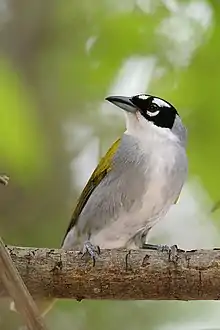Black-crowned tanager
The black-crowned tanager or black-crowned palm-tanager (Phaenicophilus palmarum) is a species of bird of the family Phaenicophilidae, which was formerly placed in the family Thraupidae. It is endemic to the island of Hispaniola (split between Haiti and the Dominican Republic) in the Caribbean.
| Black-crowned tanager | |
|---|---|
 | |
| Scientific classification | |
| Kingdom: | Animalia |
| Phylum: | Chordata |
| Class: | Aves |
| Order: | Passeriformes |
| Family: | Phaenicophilidae |
| Genus: | Phaenicophilus |
| Species: | P. palmarum |
| Binomial name | |
| Phaenicophilus palmarum (Linnaeus, 1766) | |
| Synonyms | |
|
Turdus palmarum Linnaeus, 1766 | |
Habitat
Its natural habitats are subtropical or tropical dry forest, subtropical or tropical moist lowland forest, subtropical or tropical mangrove forest, subtropical or tropical moist montane forest, and heavily degraded former forest.
Taxonomy
In 1760 the French zoologist Mathurin Jacques Brisson included a description of the black-crowned tanager in his Ornithologie. He used the French name Le palmiste and the Latin name Merula palmarum.[2] Although Brisson coined Latin names, these do not conform to the binomial system and are not recognised by the International Commission on Zoological Nomenclature.[3] When in 1766 the Swedish naturalist Carl Linnaeus updated his Systema Naturae for the twelfth edition, he added 240 species that had been previously described by Brisson.[3] One of these was the black-crowned tanager. Linnaeus included a brief description, coined the binomial name Turdus palmarum and cited Brisson's work.[4] The specific name palmarum is the Latin for "of palm trees".[5] The species is now placed in the genus Phaenicophilus that was introduced by the English geologist and naturalist Hugh Edwin Strickland in 1851.[6]
References
- BirdLife International (2012). "Phaenicophilus palmarum". IUCN Red List of Threatened Species. 2012. Retrieved 26 November 2013.CS1 maint: ref=harv (link)
- Brisson, Mathurin Jacques (1760). Ornithologie, ou, Méthode contenant la division des oiseaux en ordres, sections, genres, especes & leurs variétés (in French and Latin). Volume 2. Paris: Jean-Baptiste Bauche. pp. XXX, Plate 29 fig 1. The two stars (**) at the start of the section indicates that Brisson based his description on the examination of a specimen.
- Allen, J.A. (1910). "Collation of Brisson's genera of birds with those of Linnaeus". Bulletin of the American Museum of Natural History. 28: 317–335.
- Linnaeus, Carl (1766). Systema naturae : per regna tria natura, secundum classes, ordines, genera, species, cum characteribus, differentiis, synonymis, locis (in Latin). Volume 1, Part 1 (12th ed.). Holmiae (Stockholm): Laurentii Salvii. p. 295.
- Jobling, J.A. (2018). del Hoyo, J.; Elliott, A.; Sargatal, J.; Christie, D.A.; de Juana, E. (eds.). "Key to Scientific Names in Ornithology". Handbook of the Birds of the World Alive. Lynx Edicions. Retrieved 1 May 2018.
- Strickland, Hugh Edwin (1851). "Ornithological notes". Contributions to Ornithology. 3–4: 103-104 [104].
